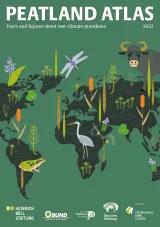
Rewetting drained peatlands will be a major challenge for societies all over the globe. Achieving success will take innovativeness, political initiative and a paradigm shift in the global economy.

For much of Western history, draining peatlands was regarded as a cultural and technical achievement. In many regions, removing water from the land was a first, vital step in the economic development of an area. But the ecological crises of our times now force us to start over again, as peatlands fulfil many important functions for both humanity and the environment. The cultural and technical achievements of the present and future will be to develop and establish new ways to coinhabit these wet landscapes.
Paludiculture, wetland restoration and solar farms are among the many promising ways of replacing previous land uses for fens and bogs. Such transformation is necessary to mitigate the climate crisis, it will help to preserve biodiversity and to enhance flood protection. In technical terms, rewetting is fairly easy: ditches must be blocked, pumps converted, and drainage stopped. But managing the social, cultural and especially the economic shifts are much more complex. To transform non-sustainable social habits of using peatlands, simultaneous changes are needed at various levels. For example, the legal framework has to be adjusted to remove the financial incentives for draining wetlands.
Stricter regulations of supply chains are needed, along with stronger controls, especially for large companies. Local authorities and organisations responsible for managing soil and water face the major task of adapting the infrastructure and ownership situations to the necessary water levels. Agricultural and forestry enterprises require new forms of management to completely upend their current approaches. Experts point out that if they are to succeed in making this huge adjustment, farming and forestry enterprises and smallholders will need public financial support, which must ensure planning security and promote new markets for the products from wet peatlands.
Every peatland has different prerequisites, in hydrological terms as well as in political terms. There can therefore be no general template for rewetting: each peatland will require a specific solution for the rewetting, and for the land use and coinhabiting afterwards. Decisions on shaping the transformation process should be made at the regional level – preferably in a joint effort by local and regional authorities, farm enterprises, soil and water associations, nature conservation bodies, Indigenous peoples and local residents, environmental groups, the companies involved, and spatial planners. These actors can all bring knowledge for the future management of the peatlands based on experience in their field. Policymakers have the responsibility of establishing participatory mechanisms to combine this knowledge and interlink different levels from local to higher levels of government and the international community.
At the European Union level, the Common Agricultural Policy (CAP) is an important mechanism for managing how peatlands are used. This stipulates that areas used for paludiculture are eligible for financial support. But these efforts conflict with other parts of the CAP that continue to support types of farming that rely on drainage. In the European Union alone, half a million hectares of peatland have to be rewetted every year to meet the Paris Agreement. With above-average emissions, the EU is still one of the main contributors to the climate crisis and holds historical responsibility for the current global inequalities.
Carbon credits might be a possible incentive for rewetting land to conserve peat voluntarily. Incentives and freedom of action are also needed for companies and cooperatives that work on paludiculture. To successfully transform the peatlands, it is necessary to take serious people’s worries about the loss of a familiar environment with which they identify, as in some parts of the world peatlands have been drained for decades. Regional cooperation can link different issues – from agriculture to product development and marketing, to tourism and nature conservation. All this will require a strong willingness for political, social and ecological innovation.
This peatland transformation – as every other socio-ecological transformation – can only be successful if the omnipresent drivers of the destructive neo-colonialist economy are overcome. It is a chance to strengthen social and political processes that declare cooperation instead of competition to be the principle of action. This processes target the preservation of natural resources and are not based on exploitation of nature and people.
Ideas of responsible land use, equal distribution of resources and consumption within ecosystem boundaries are not limited to peatland utilization. Current negotiations of land use claims follow a competitive mindset. We are in urgent need of abandoning one-dimensional utilitarian way of thinking in favour of more complex thinking that understands and respects peatlands as more than mere usable landscapes, instead promotes the protection of these essential habitats for the benefit of all living beings. Only with both, ecological resilience and a just social foundation, the global society can confront the climate crisis.


